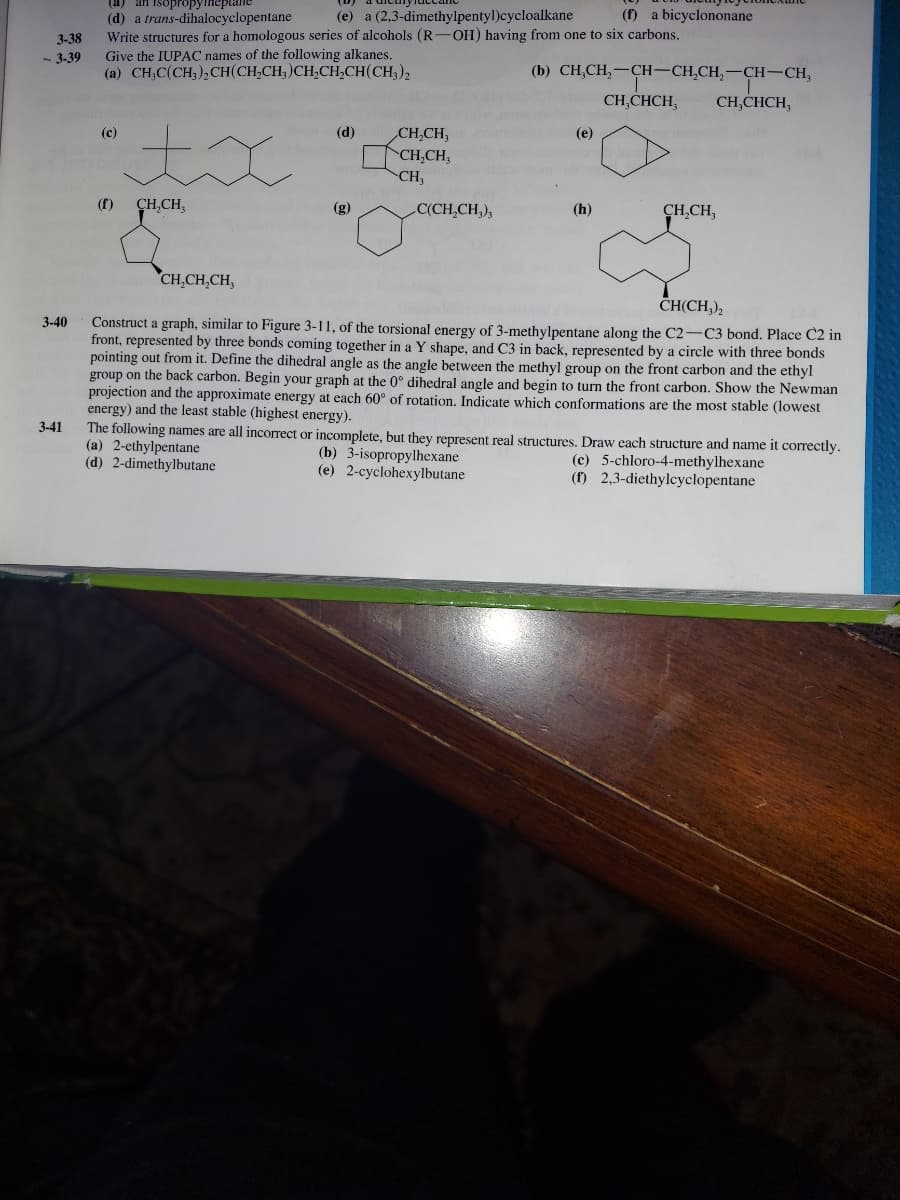Write structures for a homologous series of alcohols (R-OH) having from one to six carbons. Give the IUPAC names of the following alkanes. (a) CH,C(CH,),CH(CH,CH, )CH,CH,CH(CH,), 3-38 - 3-39 (b) CH,CH,-CH-CH,CH,-CH-CH, CH,CHCH, CH,CHCH, (c) (d) CH,CH, (e) CH,CH, CH, (f) CH,CH, (g) C(CH,CH,), CH,CH, (h) CH,CH,CH, ČH(CH,), 3.40 Conctauot imil
Write structures for a homologous series of alcohols (R-OH) having from one to six carbons. Give the IUPAC names of the following alkanes. (a) CH,C(CH,),CH(CH,CH, )CH,CH,CH(CH,), 3-38 - 3-39 (b) CH,CH,-CH-CH,CH,-CH-CH, CH,CHCH, CH,CHCH, (c) (d) CH,CH, (e) CH,CH, CH, (f) CH,CH, (g) C(CH,CH,), CH,CH, (h) CH,CH,CH, ČH(CH,), 3.40 Conctauot imil
Chemistry
10th Edition
ISBN:9781305957404
Author:Steven S. Zumdahl, Susan A. Zumdahl, Donald J. DeCoste
Publisher:Steven S. Zumdahl, Susan A. Zumdahl, Donald J. DeCoste
Chapter1: Chemical Foundations
Section: Chapter Questions
Problem 1RQ: Define and explain the differences between the following terms. a. law and theory b. theory and...
Related questions
Question
3 - 39,
Give the IUPAC names of the following alkanes
a) CH3C(CH3)2CH(CH2CH3)CH2CH2CH(CH3)2
b)
c)
d)
e)
f)
g)
h)

Transcribed Image Text:(a) an isopropy
(e) a (2,3-dimethylpentyl)cycloalkane
(f) a bicyclononane
(d) a trans-dihalocyclopentane
Write structures for a homologous series of alcohols (R-OH) having from one to six carbons.
Give the IUPAC names of the following alkanes.
(a) CH;C(CH,), CH(CH,CH, )CH,CH,CH(CH,),
3-38
- 3-39
(b) CH,CH,-CH-CH,CH,-CH-CH,
CH,CHCH,
CH,CHCH,
(c)
(d)
CH,CH,
(е)
CH,CH,
CH,
(f)
ÇH,CH,
(g)
C(CH,CH,),
(h)
CH,CH,
CH,CH,CH,
CНCH),
Construct a graph, similar to Figure 3-11, of the torsional energy of 3-methylpentane along the C2-C3 bond. Place C2 in
front, represented by three bonds coming together in a Y shape, and C3 in back, represented by a circle with three bonds
pointing out from it. Define the dihedral angle as the angle between the methyl group on the front carbon and the ethyl
group on the back carbon. Begin your graph at the 0° dihedral angle and begin to turn the front carbon. Show the Newman
projection and the approximate energy at each 60° of rotation. Indicate which conformations are the most stable (lowest
energy) and the least stable (highest energy).
The following names are all incorrect or incomplete, but they represent real structures. Draw each structure and name it correctly.
(a) 2-ethylpentane
(d) 2-dimethylbutane
3-40
3-41
(b) 3-isopropylhexane
(e) 2-cyclohexylbutane
(c) 5-chloro-4-methylhexane
(f) 2,3-diethylcyclopentane
Expert Solution
This question has been solved!
Explore an expertly crafted, step-by-step solution for a thorough understanding of key concepts.
This is a popular solution!
Trending now
This is a popular solution!
Step by step
Solved in 2 steps with 2 images

Knowledge Booster
Learn more about
Need a deep-dive on the concept behind this application? Look no further. Learn more about this topic, chemistry and related others by exploring similar questions and additional content below.Recommended textbooks for you

Chemistry
Chemistry
ISBN:
9781305957404
Author:
Steven S. Zumdahl, Susan A. Zumdahl, Donald J. DeCoste
Publisher:
Cengage Learning

Chemistry
Chemistry
ISBN:
9781259911156
Author:
Raymond Chang Dr., Jason Overby Professor
Publisher:
McGraw-Hill Education

Principles of Instrumental Analysis
Chemistry
ISBN:
9781305577213
Author:
Douglas A. Skoog, F. James Holler, Stanley R. Crouch
Publisher:
Cengage Learning

Chemistry
Chemistry
ISBN:
9781305957404
Author:
Steven S. Zumdahl, Susan A. Zumdahl, Donald J. DeCoste
Publisher:
Cengage Learning

Chemistry
Chemistry
ISBN:
9781259911156
Author:
Raymond Chang Dr., Jason Overby Professor
Publisher:
McGraw-Hill Education

Principles of Instrumental Analysis
Chemistry
ISBN:
9781305577213
Author:
Douglas A. Skoog, F. James Holler, Stanley R. Crouch
Publisher:
Cengage Learning

Organic Chemistry
Chemistry
ISBN:
9780078021558
Author:
Janice Gorzynski Smith Dr.
Publisher:
McGraw-Hill Education

Chemistry: Principles and Reactions
Chemistry
ISBN:
9781305079373
Author:
William L. Masterton, Cecile N. Hurley
Publisher:
Cengage Learning

Elementary Principles of Chemical Processes, Bind…
Chemistry
ISBN:
9781118431221
Author:
Richard M. Felder, Ronald W. Rousseau, Lisa G. Bullard
Publisher:
WILEY